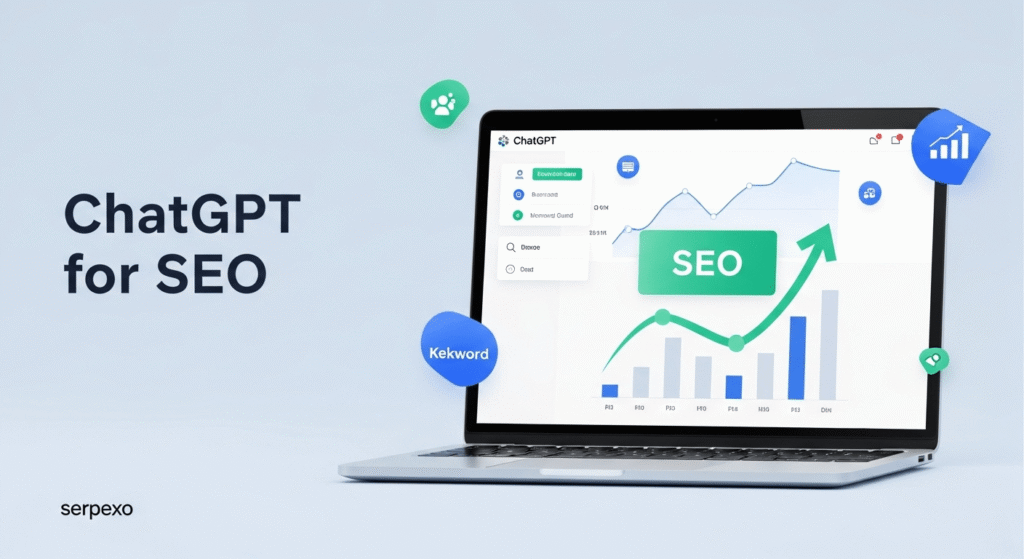
Elevate Your SEO Game with Tips, Strategies, and Prompts for 2025
The world of Search Engine Optimization (SEO) is in a constant state of flux, but the arrival of advanced AI like ChatGPT marks a paradigm shift. While some professionals view it with caution, many are discovering its immense potential to supercharge their strategies. In fact, a surprising 72% of SEO professionals are not yet leveraging AI, creating a massive opportunity for those who are willing to adapt.
So, can ChatGPT really help with SEO? The answer is a definitive yes. When used correctly, it’s not a replacement for human expertise but a powerful assistant that can accelerate research, streamline content creation, and uncover new optimization opportunities. Think of it as an incredibly knowledgeable and fast junior SEO on your team.
This guide will provide a practical, step-by-step framework for integrating ChatGPT into your SEO workflow. We’ll move beyond the hype and dive into actionable strategies, proven prompts, and the common pitfalls to avoid, empowering you to conquer search rankings in 2025 and beyond.
1. Understanding ChatGPT’s Role in Modern SEO
Before we dive into specific tactics, it’s crucial to understand what ChatGPT is and, more importantly, what it isn’t. ChatGPT is a Large Language Model (LLM) developed by OpenAI. It’s trained on a massive dataset of text and code, making it exceptionally skilled at understanding, generating, and structuring human-like language.
Its Strengths in an SEO Context:
- Efficiency and Volume: ChatGPT excels at quickly generating ideas, creating detailed outlines, and drafting content in just a matter of seconds. This ability significantly reduces the time spent on repetitive tasks, allowing you to focus on higher-level strategic work.
- Brainstorming Power: It excels at generating innovative keywords, content topics, and creative perspectives.
- Data Structuring: ChatGPT is capable of taking unstructured data, such as keyword lists, and transforming it into well-organized tables. These tables can be sorted and classified according to various criteria, like user intent or keyword type.
- Data Structuring: ChatGPT is capable of taking unstructured data, such as keyword lists, and transforming it into well-organized tables. These tables can be sorted and classified according to various criteria, like user intent or keyword type.
- Language Versatility: ChatGPT is capable of simplifying intricate topics, crafting content tailored for various audiences, and effectively translating material across different languages.
Its Crucial Limitations:
- Lacks Current Data: ChatGPT doesn’t have access to the live internet for fresh information. Its knowledge is updated only up to a specific cutoff date, preventing it from delivering insights on current search trends or evaluating today’s search engine results pages (SERPs).
- Possibility of Errors: ChatGPT can sometimes “hallucinate,” meaning it might confidently assert information that isn’t correct. It’s crucial not to fully rely on the AI’s recommendations without verifying its outputs through thorough fact-checking.
- Absence of Strategic Insight: It falls short in grasping your specific business objectives, brand identity, and the intricate subtleties of search intent as proficiently as an experienced SEO expert.
- Not a Substitute for SEO Analytics Tools: ChatGPT does not have the capability to deliver specific metrics such as search volume, keyword difficulty, or backlink analysis. It is designed to complement and enhance, rather than replace, essential SEO tools like Ahrefs, Semrush, and Google Search Console that provide these detailed insights.
While it accounts for just around 2% of Google’s web traffic by the end of 2023, its influence on content creation is indisputable. The trick lies in harnessing its strengths and balancing them with human oversight to minimize its weaknesses.
2. Supercharging Keyword Research and Strategy with ChatGPT
Keyword research forms the cornerstone of every successful SEO campaign. With its advanced capabilities, ChatGPT can serve as a potent catalyst in this endeavor. It assists in unveiling a broader spectrum of keywords while offering insights into their underlying intent.
Generating Foundational and Long-Tail Keywords
Go beyond simple seed keywords by prompting ChatGPT to consider the perspective of your audience. This approach helps to reveal long-tail keywords and related semantic terms that can capture more specific and targeted search queries.
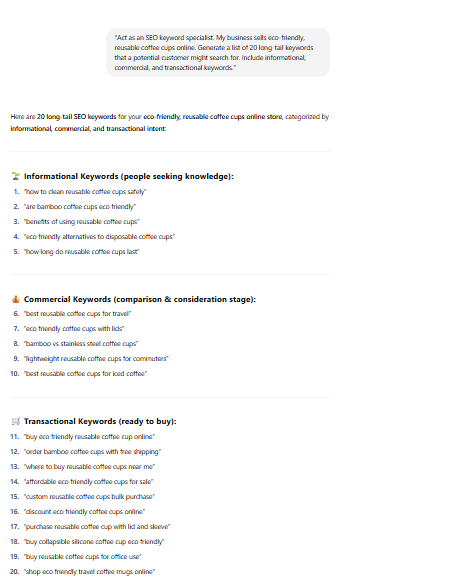
Prompt Example: “Act as an SEO keyword specialist. My business sells eco-friendly, reusable coffee cups online. Generate a list of 20 long-tail keywords that a potential customer might search for. Include informational, commercial, and transactional keywords.”
Classifying Keywords by Search Intent
Grasping search intent, which refers to the reason behind a user’s search query, is vital for effective SEO. By using ChatGPT, you can supply it with a range of keywords obtained from your existing SEO tools, and request the AI to classify these keywords according to their search intent.
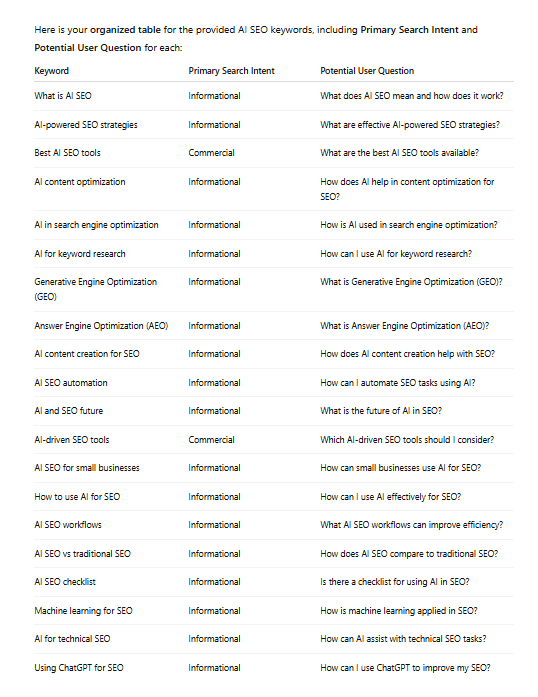
Prompt Example: “Here is a list of keywords: [paste your keyword list here]. Organize them into a table with three columns: ‘Keyword,’ ‘Primary Search Intent’ (Informational, Commercial, Navigational, or Transactional), and ‘Potential User Question.”
Building Robust Topic Clusters
Topic clusters are essential for reinforcing your website’s authority in specific subject areas when it comes to search engines. By leveraging ChatGPT, you can swiftly develop a well-rounded content strategy that centers around a main pillar topic. This process involves creating interconnected content pieces that are all related to a central theme, effectively showcasing your comprehensive coverage of the subject to search engines.
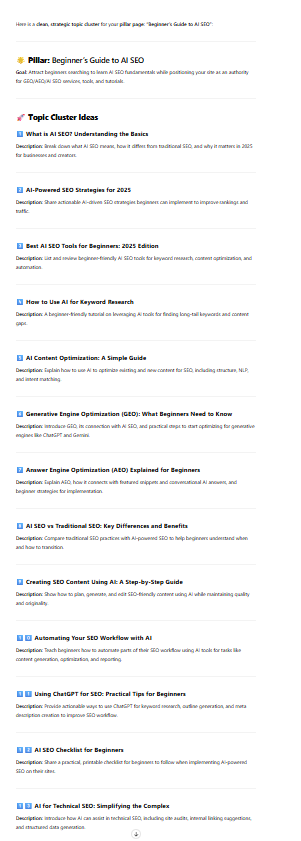
Prompt Example: “I want to create a topic cluster around the pillar page ‘Beginner’s Guide to AI SEO.’ Generate 10-15 cluster content ideas that support this pillar. For each idea, suggest a blog post title and a brief 1-2 sentence description.”
3. Crafting and Optimizing Content with AI Assistance
Content creation stands as one of the most popular applications of ChatGPT. However, the objective isn’t merely to click a button and immediately publish the output. Instead, the wiser strategy involves leveraging ChatGPT as a writing assistant to create a solid initial draft. From there, you can polish and enhance this draft further with your own human expertise, ensuring the content resonates well with your target audience and maintains a high standard of quality.
Generating Comprehensive Content Outlines
Crafting a robust outline is half the battle in writing. ChatGPT can help design a detailed framework, making sure your article is thorough and logically structured.
Prompt Example: “Create a detailed blog post outline for the title ‘AI SEO 2025: The Ultimate Guide.’ Include an H1, multiple H2s, and relevant H3s under each section. Also, suggest including a section on common mistakes and a conclusion with actionable takeaways.”

Crafting SEO-Friendly First Drafts
Leverage the detailed outline you’ve created to have ChatGPT draft an initial version of your article. Keep in mind that this draft serves merely as a foundation. It’s crucial for you to verify all facts, infuse your brand’s distinctive tone and personality, incorporate personal anecdotes or relevant case studies, and make certain the content aligns with E-E-A-T principles, which stand for Experience, Expertise, Authoritativeness, and Trustworthiness.
Optimizing Meta Titles and Descriptions
An engaging and well-crafted meta title and description can greatly influence your page’s click-through rate (CTR). Studies indicate that meta descriptions generated using AI technology have the potential to enhance CTR by as much as 5.8%.
Prompt Example: “Write 5 unique meta titles (under 60 characters) and 3 meta descriptions (under 160 characters) for a blog post titled ‘AI SEO 2025: The Ultimate Guide.’ The target audience is digital marketers. The tone should be informative and compelling, and include the keyword ‘AI SEO’.”
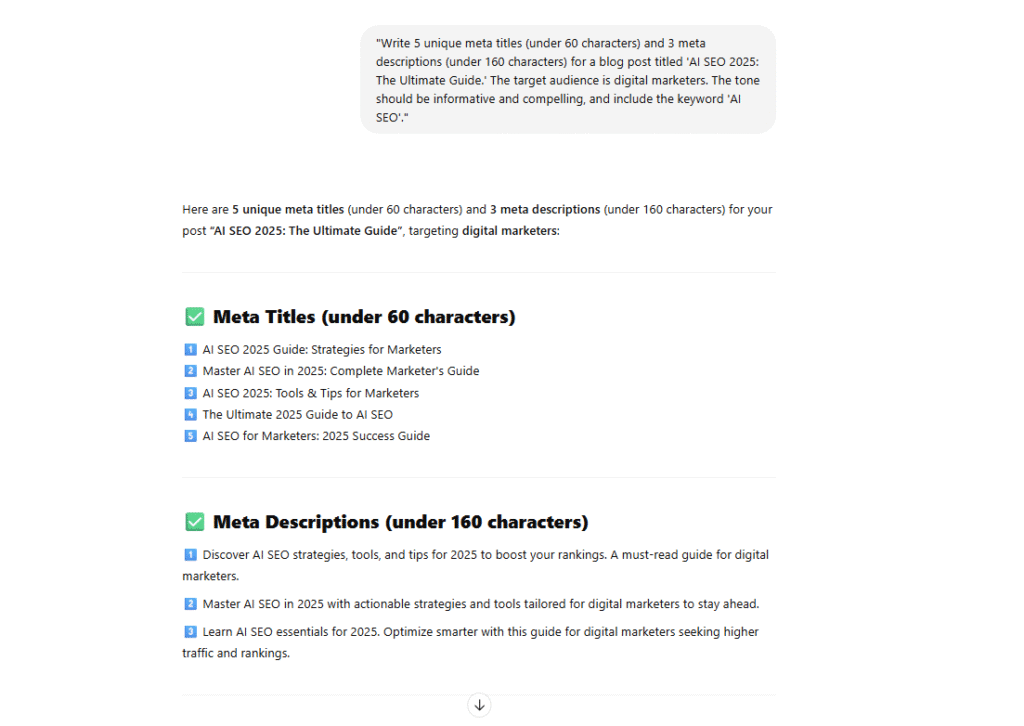
4. Identifying Content Gaps and Refining On-Page SEO
ChatGPT serves as an essential resource for assessing your current content in comparison to your competitors. By using this AI tool, you can identify areas where your content may fall short and needs enhancement. Additionally, it aids in refining various on-page elements, such as keyword usage, headings, and meta tags, ensuring they are perfectly aligned with the latest SEO best practices.
Analyzing Gaps in Your Current Content
Comparing your article manually against top-ranking pages can be a tedious and time-consuming task. ChatGPT, however, can significantly accelerate this process. Although it does not have the capability to browse live URLs, you can easily copy and paste the content from your page and a competitor’s page into ChatGPT to efficiently identify any gaps.
Prompt Example: “Here is the text from my article on ‘Sustainable Travel Tips’ [Paste your article text here]. And here is the text from a competitor’s article on the same topic [Paste competitor’s article text here]. Analyze both and create a list of key topics and sub-topics that the competitor’s article covers but mine does not.”
Improving Content Structure and Keyword Placement
Utilize ChatGPT to boost both readability and SEO optimization of your current content. This AI tool is capable of suggesting more effective headings, refining sentence structure, and recommending optimal and natural placements for keywords throughout your text.
Prompt Example: “Review the following blog post text [Paste your text here]. Suggest improvements to the content structure for better readability and SEO. Also, recommend 3-4 natural placements for the keyword ‘organic dog food’ without keyword stuffing.”
5. Leveraging ChatGPT for Technical SEO and Link Building
Apart from enhancing content, ChatGPT is also an invaluable tool for tackling more technical aspects of SEO, and it can significantly simplify and optimize your outreach initiatives.
Generating Schema Markup
Schema markup refers to a form of coding that you integrate into your website, which helps search engines gain a clearer understanding of your site’s content. This improved comprehension can result in enhanced search results, such as star ratings or FAQ dropdowns, appearing in the search engine results pages (SERPs). Creating this code might seem daunting for many, but with the assistance of ChatGPT, the process becomes straightforward and accessible.
Prompt Example: “Act as a technical SEO expert. Generate JSON-LD schema markup for an FAQ page with the following three questions and answers: Q1: What is ChatGPT? A1: It is an AI language model… Q2: How does it help SEO? A2: It helps with… Q3: Is it free to use? A3: There are free and paid versions…”
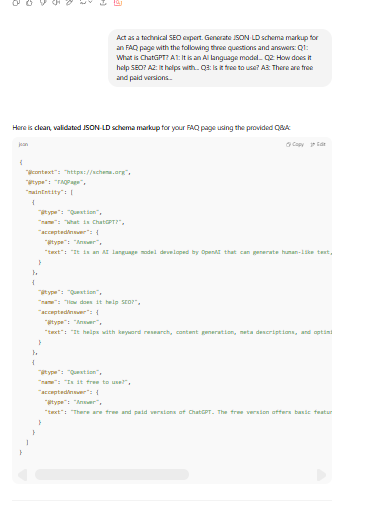
It’s crucial to ensure the accuracy of any code generated for your website. Therefore, make sure to validate it using Google’s Rich Results Test tool before you go ahead and implement it on your site.
Enhancing Link-Building Efforts with Outreach Emails
Tailoring your outreach approach is crucial for successful link-building campaigns. ChatGPT can assist by generating effective email templates that are easily customizable to fit the specific needs and preferences of your target audience.
Prompt Example: “Write a friendly and professional outreach email for a guest post pitch. My Name: [Your Name] My Website: [Your Website URL] Target Website: [Website Name] I want to pitch a guest post titled ‘5 Common SEO Mistakes Small Businesses Make.’ The email should compliment their existing content, briefly introduce my expertise, and clearly state the value my proposed article would bring to their audience.”
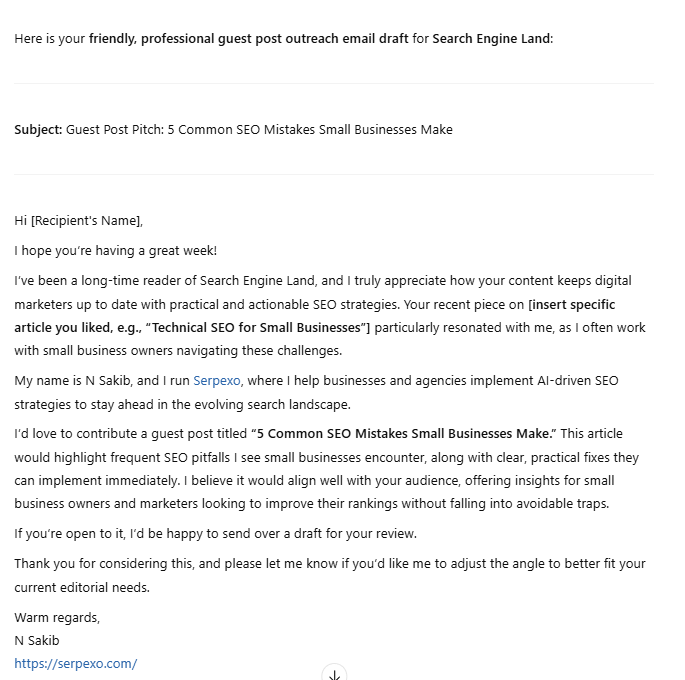
6. Mastering ChatGPT Prompts: The Key to Quality Output
The quality of what ChatGPT produces is closely linked to how well your initial queries are crafted. When you provide unclear or unspecific prompts, the outputs tend to be generic and less useful. Therefore, becoming proficient in prompt engineering is crucial. By mastering this skill, you can fully harness ChatGPT’s capabilities, especially for tasks related to SEO.
Core Principles of Effective Prompts:
Begin by assigning a specific role to ChatGPT in your prompt. Clearly define the task by instructing the AI on who to emulate. For instance, you can say, “Imagine you are an expert SEO strategist,” or “Assume the role of a professional copywriter,” and so on.
- Begin by assigning a specific role to ChatGPT in your prompt. Clearly define the task by instructing the AI on who to emulate. For instance, you can say, “Imagine you are an expert SEO strategist,” or “Assume the role of a professional copywriter,” and so on.
- Offer Background Information: Supply ChatGPT with the necessary details to understand the context. Who exactly is your target audience? What kind of business do you operate? What specific objective are you aiming to achieve with this task?
- Be Specific and Clear: Rather than using a vague request like “write about SEO,” provide a detailed prompt such as “Compose a 500-word introduction for a blog post focused on on-page SEO strategies specifically tailored for e-commerce websites.”
- Specify the Format: Clearly state your desired output. For example, “List the answers with bullet points,” “Organize the information into a two-column table,” or “Adopt a friendly and conversational tone.
- Iterate and Refine: The initial prompt you use might not achieve the desired outcome. Evaluate the AI’s response carefully, and use this information to improve your subsequent prompt by incorporating more detail or clarifying specific aspects of your request.
Creative Prompt Example: “Act as a creative director for a fun, youthful brand that sells skateboard apparel. Brainstorm 10 creative and engaging blog post ideas that blend skateboarding culture with fashion. The tone should be edgy and authentic. Format the output as a list with a catchy title and a one-sentence hook for each idea.”
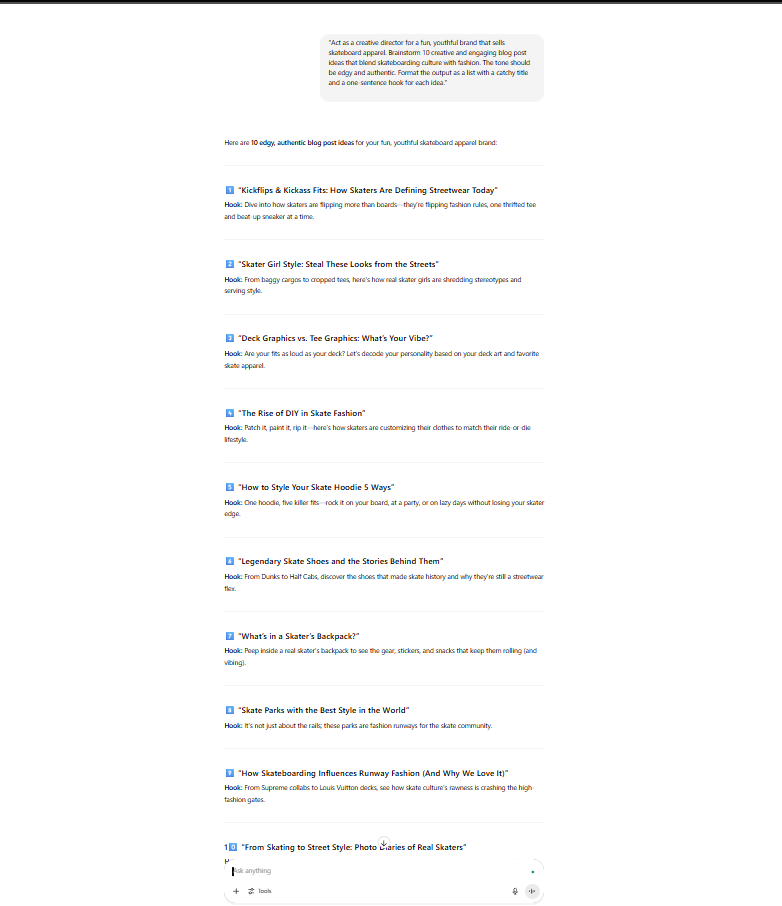
7. Maximizing Efficiency and Avoiding Common Pitfalls
Incorporating ChatGPT into your daily workflow is a strategic move aimed at enhancing efficiency rather than increasing effort. It simplifies the writing process and guarantees consistency throughout your content. This allows you to devote more time and energy to strategic planning, in-depth analysis, and the kind of creative thinking that only human insight can offer.
However, to do so effectively, you must be aware of the potential pitfalls.
How to Mitigate the Risks of AI in SEO:
- Avoid 100% Automation: Avoid the temptation to directly copy and paste AI-generated content for publication. It’s essential that every piece of content produced by AI undergoes a detailed human review process. This ensures that the content maintains the highest standards of accuracy, reflects the right tone, and maintains originality.
- Fight the Generic: ChatGPT’s training is based on publicly available internet data, which means its default output can often be average or generic. To truly make your content resonate and stand out, it’s essential that you inject your own unique perspectives, personal anecdotes, relevant data, and expert insights. These elements are crucial and non-negotiable to enhance the E-E-A-T (Experience, Expertise, Authoritativeness, and Trustworthiness) of your content.
- Always Fact-Check: Consider every statistic, date, and factual claim generated by ChatGPT as unverified information until you have cross-checked it with a trustworthy and reliable source to ensure accuracy.
- Prioritize Human Strategy: Leverage AI for handling specific tasks rather than setting overarching strategies. The final decisions regarding which keywords to focus on, which content to emphasize, and the methods for brand development should remain under your control. Employing AI ethically and responsibly involves utilizing it as a supportive tool to augment human intelligence and creativity, rather than as a substitute for them.
Your AI-Powered SEO Future
ChatGPT has proven to be far more than a fleeting innovation; it is a revolutionary asset that is redefining the digital marketing arena. Whether it’s enhancing keyword research, crafting content strategies, unraveling the complexities of technical SEO, or optimizing outreach efforts, its uses are as expansive as your imagination allows.
The future of SEO lies not in a battle between AI and humans, but in a harmonious collaboration where AI enhances human capabilities. By harnessing this technology, you can streamline routine tasks, boost your creative output, and allocate more of your precious time to strategic initiatives that deliver impactful results. Use the prompts in this guide as a starting point, explore your own ideas, and achieve a new standard of efficiency and effectiveness as you climb the search rankings.
1. Will Google penalize me for using AI-generated content?
One of the most common concerns is whether AI-generated content will lead to penalties from Google, and the answer is nuanced. Google’s policy prioritizes rewarding high-quality, user-helpful content, regardless of how it’s generated. Penalties target spammy, low-quality material, not AI-created content per se. To make effective use of ChatGPT, focus on crafting valuable, original, user-centric content that meets E-E-A-T (Experience, Expertise, Authoritativeness, Trustworthiness) standards. Simply copying generic AI output can result in low-quality content with poor performance. However, when you use AI to lay a foundation and then enrich it with human expertise and unique insights, you align with Google’s guidelines.
2. Can ChatGPT replace dedicated SEO tools like Ahrefs, Semrush, or Moz?
ChatGPT is not a replacement for dedicated SEO tools. Instead, consider it a powerful complement to your existing toolkit. While ChatGPT offers valuable insights, SEO platforms deliver essential, real-time data that is beyond its reach, such as:
- Keyword search volume and difficulty scores
- Backlink analysis
- Competitor traffic data
- Technical site audits
To maximize efficiency, integrate both tools into your workflow. Use ChatGPT to generate a wide array of keyword ideas, and then employ a tool like Ahrefs to verify the search volumes and evaluate the competition for those keywords.
3. How can I ensure the content created with ChatGPT is original and high-quality?
The responsibility for maintaining quality and originality lies with the human editor. It’s essential never to publish an unedited draft directly from ChatGPT. To ensure top-notch content, you should:
- Fact-Check Everything: Verify all stats, facts, and claims with reliable sources.
- Inject Your Expertise: Add personal experiences, case studies, unique data, and expert opinions that the AI cannot generate.
- Refine the Brand Voice: Edit the text to ensure it aligns perfectly with your brand’s tone and style.
- Check for Originality: Though ChatGPT doesn’t usually engage in direct plagiarism, its outputs may resemble existing online content. Always check your final draft with a plagiarism tool and, crucially, infuse it with enough unique insights to ensure it stands apart.
4. What is the most common mistake people make when using ChatGPT for SEO?
The most frequent mistake is perceiving ChatGPT as an all-encompassing expert instead of an adept assistant. This misstep can result in the “copy, paste, and publish” trap, producing generic, lifeless, and occasionally inaccurate content that doesn’t engage audiences or adhere to Google’s quality benchmarks. Remember, AI is a tool to enhance your abilities, accelerate your workflow, and spark creativity—the ultimate strategy, creative flair, and quality control must be your responsibility.

2 Responses